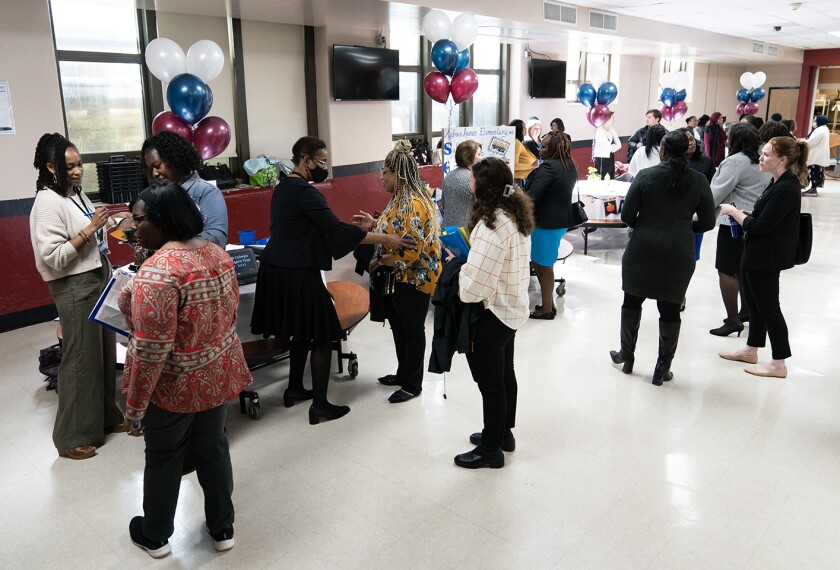The popular perception of the superintendent’s job as one of day-to-day, internal management of a complex organization is outdated and might set up aspiring superintendents for failure once they ascend to the top district role, a new report argues.
That’s because the superintendent’s job has shifted over time to become increasingly focused on forging strong community relationships, serving as the school district’s chief public advocate and spokesperson, and—often—navigating politically fraught conflicts.
When a new superintendent tries to do it all—the public-facing aspects of the job as well as the internal, day-to-day management—they can quickly get burnt out, feel overwhelmed, and think that they can’t possibly succeed, argues the report authored by Lindsay Whorton, president of the Holdsworth Center, a nonprofit organization in Texas that focuses on preparing superintendents for the leadership aspects of the job and helping districts develop pipelines of future leaders.
The incomplete picture of the superintendency could, in turn, be one contributor to the accelerating leadership churn school districts have experienced in recent years, Whorton said.
That’s why it’s time for a more refined understanding of the superintendent’s job to take hold, among school districts looking for new leadership and the programs preparing future leaders, she argues.
“What inspired this for me is the recognition that some of why the transition to the superintendent role is so hard is because we don’t do a good enough job of explaining what the job is going to be like, and I think we don’t do that because we’re afraid it will scare everybody away if we explain the job truthfully and directly,” Whorton said. “But by not doing that, we’re setting a lot of people up to struggle who, with clearer direction, may have an easier time.”
In her report, based on the organization’s work developing and refining more than 75 districts’ leadership pipelines over the past decade, Whorton says it’s critical that leadership programs adjust to the evolving nature of the job, preparing new superintendents for a role that has become increasingly about community-building, and advocacy.
Too often, the superintendent’s role is branded as the person who “does it all,” leaving leaders feeling burnt out and like they’re failing, Whorton said.
The solution for those working with aspiring superintendents: More narrowly define the superintendent’s role, be real about what it entails (even if that might dissuade some from applying), and encourage leaders to delegate—or, as Whorton writes in the report, “embrace work that is outside of their comfort zone and let go of work they love and are good at but is best done by someone else.”
The superintendency is changing from internal management to operating in the public eye
Oftentimes, superintendents rise to the position by moving through the ranks of a school district, from teacher to principal to central office administrator. The shift to superintendent requires a new mindset that’s not present in those roles, Whorton says in the report.
“You must leave behind your professional identity as the doer—the person who drives strategy and gets things done. Your new professional identity is the person who facilitates the vision,” the report says. “To do that, you must let go of the pieces (even the ones you love) and focus on the whole.”
Aspiring leaders need to understand that their job as superintendent will not primarily be managing internal departments. Instead, the job will largely entail working with people outside of the district—community members, parents, advocates, politicians, and others—to forge important partnerships that benefit the district, the report says.
It will be a job that operates “in the public eye” and, at times, becomes the focal point of heated political debates that require superintendents to know when to speak up for students and when it’s better not to engage.
It can be taxing work drawing on a skillset many educators might not naturally hold, and leadership preparation programs need to embrace it as a reality of the superintendent’s job, teaching aspiring leaders how to care for themselves mentally and emotionally in challenging times, the report says.
“You will work to maintain a positive orientation towards this scrutiny: People are watching me. That means that I have an opportunity to influence people through what I say and do,” the report says. “But there will be moments where the scrutiny feels overwhelming, and you will struggle to see it as positive. … New superintendents must build and deepen their capacity to deal with this pressure in a healthy way.”
And, possibly the most important point, Whorton said: Superintendents can’t take on all of the jobs they did in previous roles on top of their new, external-facing responsibilities by simply working harder.
Trying to do that means a superintendent risks quickly burning out, or feeling as if they aren’t cut out for the job, she said.
Instead, district leaders must feel empowered to hire a cabinet of deputies whom they can depend on to take on day-to-day, hands-on management tasks.
More clarity about the superintendency could inspire future leaders
Counterintuitively, additional clarity about the role of the superintendent—in job descriptions and leadership training—could serve to draw more future leaders to the job, Whorton said.
Some people in school systems might not think they can be a superintendent because they’re not well versed in math instruction, for example. But those same people might have other leadership and relationship-building skills that are actually more directly related to the job, Whorton said.
That clarity could also help school boards—who hire and oversee superintendents—to look beyond flashy resumes to find the candidate with the best skills to lead their districts, Whorton said.
“Maybe if they know they have these interpersonal skills and other leadership qualities, or know they can actually cultivate them, maybe more people can see themselves on the path to the superintendent role,” Whorton said. “While we’re afraid being honest might scare people away, we might also be opening the door for others.”
Disclaimer: The copyright of this article belongs to the original author. Reposting this article is solely for the purpose of information dissemination and does not constitute any investment advice. If there is any infringement, please contact us immediately. We will make corrections or deletions as necessary. Thank you.







